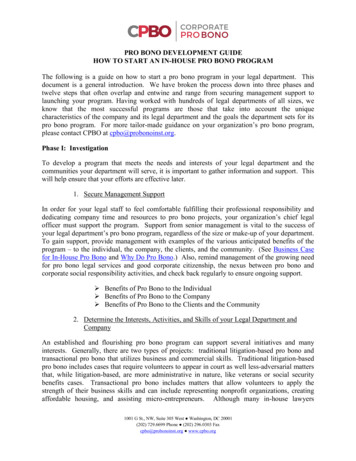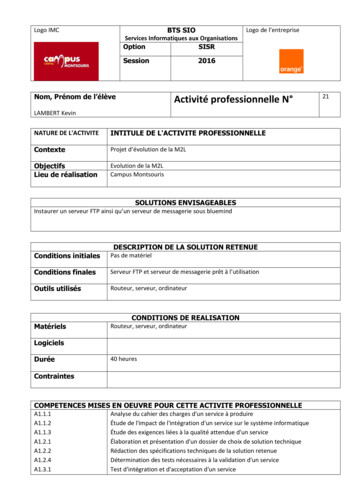
Transcription
"DUCLE ET DECORUM EST PRO PATRIA MORI": THE IDEA OF THE"SWEET AND FITTING DEATH FOR THE FATHERLAND" AND ITSCRITICS IN SELECTED WAR FILMSI. OUTLINE OF THE PAPERThe focus will be on the confrontation between "official" state-supported ideal of the "sweet andfitting" death for the Fatherland (or "la patrie" or "King and Country"), as advocated in nationalistichistories taught in the public schools, the indoctrination of conscripts, war propaganda, and popularliterature and film, and the more critical, sometimes subversive, opposing views of a handful ofnovelists and filmmakers some of whom were war veterans or saw combat first hand (such as JeanRenoir, Erich Maria Remarque, John Ford, Oliver Stone) and some of who were not (Abel Gance,Joseph Losey, Stanley Kubrick). The clash between the myth of the heroic and meaningful death forthe Fatherland and the reality of modern total war resulted, not in the overturning of the officialperspective, but in its surprising persistence and adaptability. For some patriots, the reality ofmodern war's destructiveness was incorporated into a new formulation of Horace's maxim, namelythat it was one's "hard duty" to die for the Fatherland (exemplified in the idealism of many Germanswho fought on the Eastern Front in WW2 - "Cross of Iron"). For others, the denial continued asHollywood (Errol Flynn and John Wayne) maintained that death in combat remained relativelybloodless (Sgt. Stryker in "The Sands of Iwo Jima") and would inspire others to do their duty to thenation state. The explanation for the weakness of the anti-war or "realist" view of the "sweet andfitting death" for the Fatherland (what Wilfred Owen called the "Old Lie") lies in a number offactors: the overwhelming power of state-supported media to perpetuate the myth (Goebbels and the1
Nazi film industry), the adaptability of the Christian idea of sacrifice to the needs of the modernstate, the need of audiences for exciting stories of individual heroism and chivalry, the relativelysmall number of soldiers who actually witnessed combat first hand (compared to those in support orreserve or at the home front) who might offer an alternative perspective; and the powerful need forcitizens in the modern nation state to belong to a larger community ("the nation") which legitimizesand gives meaning to the sacrifices made in wartime. Nevertheless, Milestone's and Remarque'scritique of the ideal of the "sweet and fitting" death for the Fatherland in "All Quiet on the WesternFront" (1930) remains the classic critical formulation in film and its power still serves as a grimwarning of the murderous potential of the nation state in the century of total war.II.INTRODUCTIONA. Conference Theme: "National Cinemas - Sites of Resistance?"In my paper I want to explore an idea which has been used by the state and its supporters to justifyor legitimize the activities of men in wartime, namely that it is "proper", even "beautiful" (sweet), todie for the fatherland (nation state) in battle.The connection I see with the theme of this Conference - "National Cinemas - Sites ofResistance?"- is that the new nation states which had emerged in the late 19thC quickly saw thepossibilities of cinema to reach a huge popular audience with messages of patriotism, sacrifice, andmartial glory. Nation states in the 20thC had two paths they could follow in using the cinema forpropaganda purposes. Firstly they could "nationalise" the cinema as happened in Nazi Germanyafter 1933 and Stalinist Russia after 1924. National cinema in these countries were literally the"creatures" of state policy in order to guarantee that the needs of the nation state would be served bythe new medium and that possible "sites of resistance" or countervailing voices did not appear orwere not given an audience.Or secondly, they could encourage and assist private filmmakers to serve both the need of the statefor willing and obedient soldiers in time of war and the need of the film producers and studios tomake a profit in a highly competitive industry. In this case the cinema industry is privately ownedbut "voluntarily organised" by the state (e.g. the voluntarily given support of much of Hollywood to2
the US war effort after 1941), substantially subsidised or otherwise "protected" by the state in orderto achieve the same purpose (the "national cinemas" of France and Australia at various times). In thelatter case, the state may provide monetary or materiel support to favoured filmmakers (it is hard tomake a realistic war film if the military refuses to lend you large numbers of tanks or warships),make it difficult for critics of state policy to get films made or distributed, or outright censorship ofcritics. I would argue that the purpose of "national cinemas" is to maintain existing elites in power,to mobilise citizens in support of state policy (especially war) and create or manufacture "consent."A third type of "national cinema" is the product of a large number of independently actingfilmmakers, writers, producers, etc who happen to share a common or relatedculture/language/history. The cinema these people produce is "national" in the sense that commontraits or a particular "flavour" of films emerge as a result of shared ethnic, linguistic or regional ties.It is not an "official national cinema", produced by deliberate state policy, but an "unofficial nationalcinema".Turning to the second part of the conference title, where are the "sites of resistance" and whoinhabits these sites?1 Both "official" and "unofficial" national cinemas can be "resisted" (opposed,challenged, questioned, undermined) by disaffected individuals and groups. In the case of "officialnational cinemas" those groups or individuals who are oppressed or marginalised by the state mayseek to express an alternate view to the official line but are driven underground or out of business(e.g. Marxists like Bertolt Brecht who thrived in the late Weimar Republic are driven undergroundor expelled by the new Nazi cinema after 1933; the vigorous artistic experimentalism whichappeared in the early 1920s in the Soviet Union was suppressed as the Stalinist regime sought tomonopolise all avenues of cultural expression and to stifle any dissent from "party lines"). There arealso those who are excluded from access to state subsidies, those who oppose official ideology,films of non-nationals (i.e. the Jewish producers in Hollywood in the 1930s were outsiders who1 ] Perhaps the creator/s of the Conference theme had in mind the title of Jay Winter's book, Sites of Memory. Sites of Mourning: TheGreat War in European Cultural History (1995) (Cambridge University Press, 1996) which omits the important locality of "site ofresistance" to the "Great War". I wonder about the significance of the question mark at the end - is there some doubt in the organisers'minds about whether any sites of resistance exist and if so where they might be located (within or outside the putative nationalcinema)? and resistance to what? resistance to the very idea of a "national cinema" or resistance to aspects of "national cinema? Noneof this is clear in the title. In my case I felt I had to invent my own notion of a "site of resistance" to what I regarded to be a lynch pinof the nation state (and the "national cinema" which evolved in or from it), viz. the patriotism which extols the death of the individualin its defence.3
opposed the isolationism of American policy and sought to make American more aware of the threatposed by fascism in Europe, e.g. Curtiz, The Adventures of Robin Hood (1938)). The inability ofOliver Stone to get "Platoon" produced during the patriotic early 1980s under Pres. Reagan, therefusal of the US military to assist in providing equipment for the filming drove Stone and hisEnglish backers to shoot in the Philippines and use American-supplied Philippino militaryequipment.In the case of war films, it is not surprising that even liberal democracies do not allow anti-war filmsto be made while the war is taking place. The demands of war fighting produce a uniformity of"consent" which makes it very difficult for opposing or "resisting" voices to be heard. Typically, it isnot until 10 years or so have passed before critics of official state policy are able to make filmscriticizing the official state position ("Hart's Ten Year Rule"). The clearest example of this is thespate of anti-war novels and films which appeared in the late 1920s up to the coming to power of theNazis in 1933 (AQWF, Westfront 1918). Followed by the mildly anti-war or confused films aboutVietnam which appeared in the late 1970s (Apocalypse Now, The Deer Hunter) and the "secondwave" of more explicitly anti-war films which appeared in the late 1980s (Platoon, FMJ).An important sub-category of films which "resist" the official state line are those war films made byfilmmakers who themselves were war veterans or who based their films on the accounts of thosewho had been veterans. Occasionally, filmmakers who usually had conformed to the official stateline sometimes departed from the simplistic depiction of war/battle to produce a more complex,thoughtful, and hence more ambivalent perspective which also undermined the official state line(e.g. John Ford, They Were Expendable (1945) and Mizoguchi, The Loyal 47 Ronin (1941-2)). Theiroften opposing accounts of war are particularly interesting and important because of the "bearingwitness" factor2.David Hart's List of (Anti)-Patriotic Films2 Samuel Hynes, The Soldiers' Tale: Bearing Witness to Modern War (New York: Penguin, 1998).4
Patriotic filmsWW1 Ambivalent patriotismWW1Pressberger, The Life and Death of ColonelWW1Abel Gance J'Accuse (1937)Milestone, AQWF(1930)Blimp (1943) Critics of patriotism Peter Weir, GallipoliRenoir, The GreatIllusion (1937)(1981) Kubrick, Paths of Glory(1957) Losey, King andCountry (1964)WW2 WW2Charles Chauvel, Forty Thousand Horsemen(1940) On (1942)Mizoguchi, The Loyal John Ford, They WereExpendable (1945) Spielberg, SavingPrivate Ryan (1998)Olivier, Henry V(1944) Veit Harlan, Kolberg(1945) 47 Ronin (1941)Raoul Walsh, TheyDied With Their BootsWW2Dwan, Sands of IwoJima (1949)5Mike Nichols, Catch-22(1970) Sam Fuller, The Big RedOne (1980)
Milestone, The Halls ofMontezuma (1950) Annakin, Marton,Wicki, The LongestDay (1962)Korean WarKorean War Korean WarMilestone, Pork Chop Hill (1959)Sam Fuller, The SteelHelmet (1951) Robert Altman,M*A*S*H (1970)Vietnam War John Wayne, TheGreen Berets (1968)Vietnam War Vietnam WarMichael Cimino, The Deer Hunter (1978)Oliver Stone, Platoon(1987) and Born of the4th of July (1989)Other WarsOther Wars Other WarsAbel Gance, Napoleon (1927)Paul Verhoeven,Starship Troopers(1987)6
B. Hiding the True "Face of Battle"There is a very stark contrast which can be drawn between the "face of battle" (to borrow the title ofJohn Keegan's pioneering book 3 which is revealed in popular culture (school textbooks, art,literature, film) and that which emerges from a close study of selected memoirs, works of historyand even some films. Soldiers go to war with a preconception of what they might expect toexperience in battle and how they should behave under fire, a preconception which is drawn from arange of sources such as school history textbooks, newspapers, adventure stories, photographs,films, and the oral tradition passed down from male relatives who fought in previous wars.4Examples include the adventure stories of G.A. Henty and Rudyard Kipling for soldiers enteringWW1; Rupert Brooke, "Gone with the Wind" for soldiers going into WW2 (William Manchester);John Wayne for those entering the Vietnam War; and, Holmes speculates, the "militarypornography" of the more explicit novels of Guy Sajer and Sven Hassell on the generation ofsoldiers of the mid-1980s.What emerges from his account (and others) is that a huge gulf exists between the preconception andthe reality of battle. The sense of what war is like and the expectations which are created on thesoldier to live up to this "literary", constructed "face of battle" is contradicted oftentimes by thesoldier's personal experience of battle. Holmes concludes that this conflict between reality andpreconception sets the stage for military failure and the physical and psychological breakdown ofsoldiers (in the field I presume he means):The risks of such gulfs between preconception and reality are colossal. Battle is atraumatic experience at the best of times. But if it produces not only all the stresses ofnoise and danger but also the dislocation of expectation, then the risks of failure andbreakdown loom large. (S.L.A.) Marshall believed that the average soldier goes tobattle, the 'supremely testing experience of his lifetime almost as a total stranger.'53 John Keegan, The Face of Battle (New York: Viking Press, 1976).4 Holmes, Firing Line (1985), pp. 59-73 gives a brief but very useful discussion of the range of sources which have influenced thepreconception of battle of some of the soldiers who have fought in the 20thC.5 Holmes, Firing Line (1985), p. 73.7
I would add to this some other non-military consequences which should concern the historian of warand popular culture, namely the bitterness, disillusionment and resentment that men feel when theybelieve they have been duped and the psychological problems (guilt, sense of failure, grief, andstress) which can sometimes emerge when the veterans have returned to civilian life. This is mostnotably the case in the problems many Vietnam War veterans have experienced not just as a resultof losing the war but also as a result of not being able to live up the ideal of the combat soldierembodied in the person of "John Wayne" created by Hollywood in the 2 decades between the end ofWW2 and the escalation of the conflict in Vietnam in 1965.6 Thus I would argue that it importantfor societies to have the most realistic understanding possible of the nature of battle/war in order thatwars not be undertaken too lightly, and that the men who go into combat have a closer matchbetween expectation and reality of battle.It is an interesting question to ask oneself when and how, if at all, did ordinary people (noncombatants) get to learn about "the face of battle". Much of the stir caused by Spielberg's WW2combat movie "Saving Private Ryan" (1998) has been caused by the unflinching depiction of thenature of combat for those American soldiers who landed at Omaha Beach in Normandy on 6 June1944. For many viewers it is the first time in 54 years that the nature of an amphibious assault underfire by modern weapons has been depicted in such graphic detail on the screen. The history(chronology?) of how viewers came to see a depiction of battle like Spielberg's illustrates theargument I would like to make in this paper, namely that1. men go into battle with (mis)perceptions of battle either based upon the circumstances ofprevious wars or highly stylised heroic and patriotic stories which bear little or noresemblance to modern warfare - many soldiers believe that it is both possible and perhapsnecessary that it is "sweet and fitting to die for the fatherland"2. information about the nature of contemporary battle is deliberately withheld by themilitary authorities during the war for reasons of propaganda and morale (photographs ofdead or mutilated soldiers are censored)7 - the state does not wish its citizens to have6 Jonathan Shay, Achilles in Vietnam: Combat Trauma and the Undoing of Character (New York: Touchstone, 1995).7 George H. Roeder, Jr., The Censored War: American Visual Experience During World War Two (New Haven: Yale UniversityPress, 1993).8
information which might lead them to question the ideal that it is sweet and fitting to diefor the fatherland.3. the political and military authorities continue to produce films (and other accounts) duringthe war which perpetuate the myths about the possibilities of heroic and patriotic sacrificeon the battlefield - the dilemma faced by the authorities is that they must show enough"realism" so as not to make the propaganda laughable but not so much that it discouragespeople from supporting the war effort; gradual evolution of idea that it is one's "hard duty"to sacrifice one's life for the state (no longer "sweet" or "seemly")4. after the war there is a "conspiracy of silence" on the part of most veterans who do notdivulge the "secret knowledge" they have about the nature of combat partly because theywant to forget the war and partly because their immediate families could not comprehendtheir stories if they were told5. gradually a trickle of memoirs, histories, novels, films appears after the war which begin toprovide some details of the "face of battle" ("Hart's Ten Year Rule" - it often takes 10years or so for the first critical accounts begin to appear) but which does not undermine theofficial or popular account of the war6. the official account/view of the war is reinforced when important anniversaries of the warare celebrated, a "standard account" of the war emerges in popular novels, TV and film,and school history textbooks7. a few "dissenting voices" (novels, memoirs, films) appear to challenge the standardaccount but they are few in number and marginalised in effect8. eventually, some aspects of the more "realistic" or critical perspective are incorporated intothe standard account but this does not undermine the standard account but is used toemphasize the patriotic "sacrifice" made by those who took part.I believe this "chronology" is true for the major wars of the 20thC with only a few minor variationsresulting from the peculiarities of time and place.9
III.WAR, PATRIOTISM AND MODERN NATION STATEA. The Origin of the Idea of "Pro patria mori"The origins of this sentiment lie deep within Western classical culture8, having perhaps its"classical" formulation in one of the Odes of Horace (Book Three, no. 2) where the following phraseappears:Dulce et decorum est pro patria moriThere are various translations which could be given for this phrase. One I like is "How sweet andfitting it is to die for the fatherland" or "the glorious and the decent way of dying is for one'scountry". The translator of the Penguin edition of Horace's Odes translates the stanza as follows:The glorious and the decent way of dyingIs for one's country. Run, and death will seizeYou no less surely. The young coward, flying,Gets his quietus in the back and knees.9Jonathan Swift translated the same verse in the early 18th century giving it a religious twist anddedicating it "To the Earl of Oxford":How blest is he, who for his Country dies;Since Death pursues the Coward as he flies.The Youth, in vain, would fly from Fate's Attack,With trembling Knees, and Terror at his Back;Though Fear should lend him Pinions like the Wind,Yet swifter Fate will seize him from behind.108 Ernst Kantorowicz has explored the significance of this idea in medieval political thought in a number of works. Its political andcultural impact in the modern period still requires exploration. See Ernst H. Kantorowicz, "Pro patria mori in Medieval PoliticalThought," American Historical Review, October 1950, vol. LVI, no. 1, pp. 472-92 and The King's Two Bodies: A Study in MedievalPolitical Thought (1957) (Princeton University Press, 1981), "Pro patria mori" pp. 232-72; also Gaines Post, "Two Notes onNationalism in the Middle Ages," Traditio: Studies in Ancient and Medieval History, Thought and Religion (New York: FordhamUniversity Press, 1953), pp. 281-320.9 See The Odes of Horace, trans. James Michie (1964) (Harmondsworth: Penguin, 1973), p. 141.10 The Faber Book of War Poetry, p. 1.10
It can't be said that the author, Horace, penned this sentiment of noble patriotic death without havinghad any personal experience of war. In fact, he had fought for Brutus on the losing side in the Battleof Philippi 42 BC which was one of the Civil Wars which broke out after the assassination of JuliusCaesar. A satirist of his calibre might be suspected of writing this "tongue in cheek" but it seems notto be the case. He actually meant what he said and his assertion of the nobility of dying for the"patria" has been in Kenneth Baker's words, "chiselled into innumerable war memorials andparaphrased by leaders throughout history, both to encourage men to make the supreme sacrifice andto console the bereaved."11 I would add that in the 20th century this same sentiment has been etchedinto the celluloid of innumerable patriotic films.It is my contention that the modern nation state adapted this classical notion of military obligationand sacrifice to the needs of "nation building" in the late 19th and early 20 centuries. The Latinreading educated elites were able to absorb Horatian ideas of patriotic sacrifice directly from theLatin original. In the First World War many educated middle class French, German and Britishsoldiers went to the trenches of the Western Front ready to act on this sentiment of "sweet andfitting" death for the fatherland.B. Militaristic Patriotism in England before WW1The centrality of Greece and Rome in secondary and higher education in the 19thC is well known.What is less well known is how Roman ideas of war, empire, manliness and heroism weretransmitted to several generations of young men, many of whom were to fight in WW1 attemptingto emulate the classical ideal of patriotism which they had learnt at school. Norman Vance noteshow readily statesmen and intellectuals seized upon certain lines of Horace:It was inevitable that patriots and politicians and the designers of war memorials wouldrecall that Horace had observed that it was sweet and seemly to die for one's country('Dulce et decorum est pro patria mori', Odes 3.2.13). In the long peace betweenWaterloo and the Crimean War, Britons had few opportunities to do so, but that did11 The Faber Book of War Poetry, ed. Kenneth Baker (London: Faber and Faber, 1997).11
not deter them from recommending patriotic death to people of other nations. Byronset the tone by dying for Greece at Missolonghi.12Julia Haig Gaisser has explored the use of "the Imperial Horace" by public school teachers andtranslators of and commentators on Horace for cheap schoolbook editions to "beat Horace into theminds and hearts of young Britons" in Victorian and Edwardian Britain.13 Rudyard Kipling's storiesof schoolboys like Chalky, or moral tales like "Regulus" (1908-11), spread the Horatian ideal to apopular audience outside the gates of the elite public schools. One widely used translator andcommentator for schoolboys was Arthur Macleane whose edition of Horace first appeared in 1853and went through 4 editions and many reprintings over the next quarter century.14 Macleane, forexample, summarised the manly sentiments of the Second Ode as:Contentment is to be learned in arms and danger. To die for our country is glorious,and death pursues the coward. Virtue is superior to popular favour or rejection, andopens the ways to the skies, and rises above the dull atmosphere of this world. Goodfaith too has its reward, and I would not be the companion of the man who neglects it,lest I share his sure reward.15The assistant master of Charterhouse School from 1876-1910, T.E. Page (whom Gaisser describes as"one of the most important and influential teachers of his day" whose text was "the text of choice inmost schools") glossed another Horatian Ode as:Let the boy, who means to be a man, lead a simple and hardy life as the best trainingfor a soldier's career; in the field let the foeman fear him, and let his courage beinspired by the thought that death is glorious indeed when encountered in his country'scause: the true man is independent of the honours the mob can give or withhold, hetreads a path of his own, heaven and immortality are his reward, for rewarded his12 Norman Vance, The Victorians and Ancient Rome (Oxford: Blackwell, 1997), p. 190.13 Julia Haig Gaisser, "The Roman Odes at School: The Rise of the Imperial Horace," Classical World (1994), vol. 87, no. 5, pp. 443-56.14 Gaisser, p. 445.15 Gaisser, p. 453.12
uprightness and true reverence shall surely be, as certainly as profanity and guilt shallbe punished.16A third example of the militaristic patriotism taught to schoolboys on the eve of WW1 comes fromWilliam Medly who strangely enough taught at a Friends School in Leeds from 1870-1908 andwhose commentary on Horace was published by Oxford University Press in 1910 with the followingselection of lines:But reverting to Horace, we see next this stripling, now grown to hardy manhood. Heloves to dwell sub divo [3.2.5], out in the open beneath the unsheltered skies. Like thebronzed veteran on the south African veldt he scorns the cover of tent or fortress. Outin all weathers, exposed to sun and wind and lashing storm, there let him with a fiercedelight live out his life.In the fourth stanza the crown of gallantry, reserved for this citizen-soldier of Rome, iswon. pro patria mori! [3.2.13] this is no death; rather it is the very crown of life - lifemade perfect. Death awaits us all. This thought is ever on the poet's lips. But heredeath is a prize; a prize which falls to few.17C. Critics of PPM - Wilfred Owen "The Old Lie" (1917)Perhaps the most famous example of the angry rejection of what Gaisser calls "the clash of the idealof exalted patriotism and noble death in battle with the realities of World War I" is Wilfred Owen'spoem "The Gas Attack" or "Dulce et Decorum Est" written in October 1917.18 The first 3 stanzasdescribe a gas attack and the haunting image of a comrade without a gas mask dying before his veryeyes. Then comes the final long stanza with his angry denunciation of "the old Lie":If in some smothering dreams you too could paceBehind the wagon we flung him in,16 Gaisser, p. 453.17 Gaisser, p. 454.18 Gaisser, p. 455.13
And watch the white eyes writhing in his face,His hanging face, like a devil's sick of sin;If you could hear, at every jolt, the bloodCome gargling from the froth-corrupted lungs,Obscene as cancer, bitter as the cudOf vile, incurable sores on innocent tongues, My friend, you would not tell with such high zestTo children ardent for some desperate glory,The old Lie: Dulce et decorum estPro patria mori.19Owen translates Horace's patriotic phrase in a letter to Susan Owen, 16 October 1917 as "Thefamous Latin tag means of course It is sweet and meet to die for one's country. Sweet! Anddecorous."20D. Critics of PPM - Bertold Brecht (1916)Gaisser quotes a passage from an essay by Brecht criticizing the school's use of Horace aspropaganda and describing Horace as "the Emperor's fat court jester". The essay was written in 1916when Brecht was 17 and still at high school and nearly led to his expulsion from the Gymnasium.He wrote:It is always hard to depart from life.Only the empty-headed can push folly to the pointof speaking of an easy leap through the dark door, and this only as long as they believethemselves far from the last hour. But once the Bone Man comes to themselves, thenthey take their shield on their back and run away, like the Emperor's fat court jesterwho devised this saying.2119 The Poems of Wilfred Owen, ed. Jon Stallworthy (1985) (London: The Hogarth Press, 1988), p. 117.20 Wilfred Owen, Selected Letters, ed. John Bell (Oxford University Press, 1985), p. 283. See also Jon Stallworthy, Wilfred Owen: ABiography (Oxford University Press, 1977), p. 228.21 Gaisser, p. 45614
E. Sacrificing One's Life for the State - Fatherland/MotherlandThe political philosopher Jean Bethke Elshtain has concluded from her analysis of "war stories"taken from literature and political thought (Plutarch, Rousseau, Hegel), that "one incessant andinsistent theme" emerges, namely the theme of sacrifice, typified by the following sentimentexpressed by Nathan Hale who died at the hands of the British during the American Revolution - "Ionly regret that I have but one life to give for my country." But, whereas the traditional formulationof sacrificing one's life for the state in time of war was to a "patria" or fatherland, Elshtain notes an18th and 19thC "femininization" of the state which demands the sacrifice of her sons:The young man goes to war not so much to kill as to die, to forfeit his particular bodyfor that of the larger body, the body politic, a body most often presented andrepresented as feminine; a mother country bound by citizens speaking the mothertongue.22She also notes that "the sovereign may bear a masculinized face, but the nation itself is feminized, amother, a sweetheart, a lover" and that the sacrifice demanded of the nation's "sons" is nothing lessthan that which one's own "birth mother" might demand if she were threatened by attack.23A key question which this paper wishes to ask is one also posed by Elshtain, namely how the statewas able to forge an ethic of sacrifice on the part of its male citizens to give their lives for the statein wartime:. how did it come about that war for the king, then for country, then for more abstractideals and demands for the 'imagined community', got intermingled and served toframe the horizon within which the will-to-sacrifice was, and is, ongoingly forged? MaxWeber writes of the 'consecrated meaning' of death for the warrior, the conviction thathis death alone provides the needed support for the 'autonomous dignity of the polity22 Jean Bethke Elshtain, "Sovereignty, Identity, Sacrifice," in Reimagining the Nation, ed. Marjorie Ringrose and Adam J. Lerner(Buckingham: Open University Press, 1993), pp. 159-75. Quote from p. 160. See also her Women and War (Brighton: The HarvesterPress, 1987).23 Elshtain, "Sovereignty, Identity, Sacrifice," p. 169.15
resting on force'. Only a preparedness to forfeit one's own life rounds out, orinstantiates in all its fullness, devotion to the political community, and only suchdevotion affords any dignity to a politics that would otherwise turn on brute force.Alth
Starship Troopers (1987) 7 B. Hiding the True "Face of Battle" . John Keegan's pioneering book 3 which is revealed in popular culture (school textbooks, art, literature, film) and that which emerges from a close study of selected memoirs, works of history and even some films. Soldiers go to war with a preconception of what they might expect to










